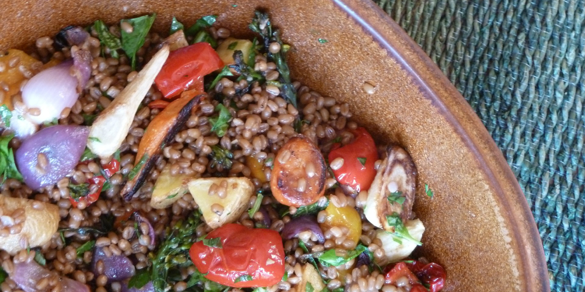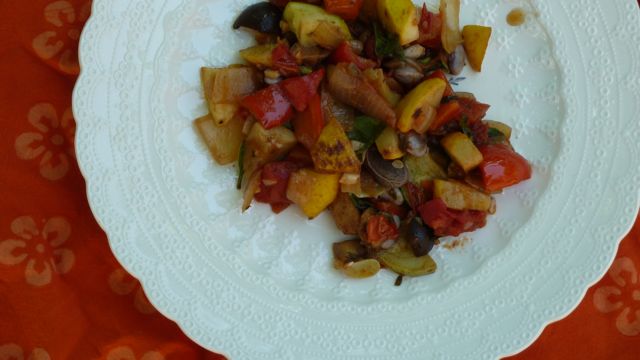Gluten-free is one of the hottest cooking topics around—and no longer the exclusive realm of those with celiac’s disease or gluten-intolerance. More and more diners are looking for strategies to cut down on wheat and grain products. With that in mind, this week I’m delighted to welcome guest blogger, E. Chloé Lauer, an expert on gluten-free cooking and nutrition. Chloé has an enthusiasm for clean eating that’s infectious, and her approach is both practical and easy. And simply delicious. Chloé’s recipe prompted me to take a peek at our archives, to see how we stack up in the gluten-free world. You’ll notice a new gluten-free tag in our recipe index this week (right side bar), that should make it easier to identify wheat-free recipes. Watch how the category grows as I slog through the files over the next few weeks.
Tag Archives: eggplant
Ratatouille: Summer’s Stew
Iowa City, Iowa — We’re visiting family in the Midwest, and today is another in a series of 90-plus-degree scorchers. Hot stew on a hot summer day? The idea sounds absurd, if not downright tortured. The usual loyal kitchen helpers are likely to scatter the moment you crank up the stove. No doubt you’ll be left chopping and stirring in solitude. No worries. Ratatouille is a simple dish, just right for one cook. Use vine-ripened tomatoes, tender-skinned squash and sweet peppers, plus plenty of garlic and onion. Sauté each vegetable in olive oil, one at a time, then stir them all together in a sturdy pot and simmer the mixture, so the flavors commingle in a magical way.
Farro with Roasted Vegetables

This versatile vegetarian dish serves equally well as a main course or a hearty accompaniment. Substitute whatever produce you have on hand — zucchini, eggplant, cherry tomatoes and peppers in the summer or carrots, parsnips, fennel, broccoli, cauliflower and winter squash in colder months. Whatever vegetables you choose, the flavor is sure to be deep, complex and oh so good. Roasting takes any ordinary veggie and intensifies the flavors, delivering taste that’s utter magic.
Farro is an ancient wheat grain from Italy. It has a chewy, soft texture and nutty flavor when cooked. It’s worth seeking out — you’ll find it at Whole Foods and other quality markets.
Lentil and Pinto Bean Chili
This dish draws inspiration from many sources—vegetarian chilis in Julee Rosso and Sheila Lukins, The Silver Palate Goodtimes Cookbook and Didi Emmon’s, Vegetarian Planet. And there’s the Indian lentil stews I’ve learned to love over many years of marriage, like dal makhani which pairs lentils with kidney beans. We’ve been experimenting and doctoring over years, each time we stir up this chili, we tweak it a bit, here and there. The first version began with sautéed eggplant courtesy of the Silver Palate. Years later, lentils and beer were added via Emmon’s suggestion, and somewhere along the line the spices that go into dal were stirred in. If we have zucchini in the garden, we add it (toward the end of cooking). Or carrots and celery. Fennel even. The beans we choose depend on what’s in the cupboard—cannellini, black, kidney and garbanzo are all able partners.
Though this chili is simple to prepare and can be on the table in an hour or so, it’s even better after a day or three, which allows the flavors to mingle, mellow and come together.
I like to grind my own spices—a trick I learned from my mentor in Indian cooking, my mother-in-law—since the flavor is far superior. There’s a small coffee bean grinder stored in my cupboard, reserved just for spices. Buy bags of cumin and coriander seed at an Indian market in bulk—the cheapest prices you’ll find anywhere.
We love Spanish pardina lentils here—they keep their shape as they cook, and have a lovely light brown hue—but substitute any earth-colored lentil. French green lentils, lentilles du Puy, would be nice too. If you make a substitution, be sure to test the lentils for doneness, as each variety cooks at a different rate. You may need to add more water too, depending on the variety.



